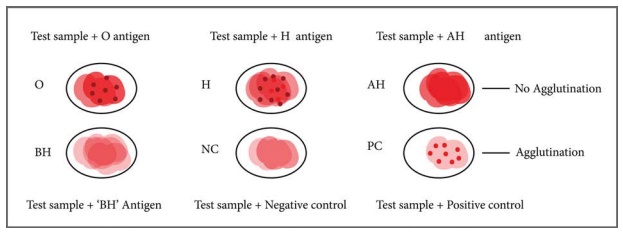Practical Experiment | Microbiology - Widal Test (Slide Test) | 12th Microbiology : Practical Experiment Manual
Chapter: 12th Microbiology : Practical Experiment Manual
Widal Test (Slide Test)
Widal Test (Slide Test)
Aim
To carry
out the widal test for the given blood sample and to determine the presence of
antibodies against salmonella antigens.
Theory and Principle
Widal
test is a serological test which is used for the diagnosis of enteric fever or
typhoid fever. Typhoid or enteric fever is caused by a gram negative bacteria Salmonella enterica (Salmonella Typhi or Salmonella Paratyphi). Salmonella
possess O antigen on their cell wall and H antigen on their flagella. On
infection, these antigen stimulates the body to produce specific antibodies
which are released in the blood. The Widal test is used to detect these
specific antibodies in the serum sample of patients suffering from typhoid
using antigen-antibody interactions. These specific antibodies can be detected
in the patient’s serum after 6 days of infection (fever).
Salmonella Typhi possesses O antigen on the cell wall and H
antigen on flagella. Salmonella Paratyphi
A and S. Paratyphi B also possess O
antigen on their cell wall and but
have AH and BH antigen on their flagella respectively.
Widal
test is an agglutination test in which specific typhoid fever antibodies are
detected by mixing the patient’s serum with killed bacterial suspension of
Salmonella carrying specific O, H, AH and BH antigens and observed for clumping
ie. Antigen-antibody reaction. The main principle of Widal test is that if
homologous antibody is present in patient’s serum, it will react with
respective antigen in the suspension and gives visible clumping on the test
slide.
Requirements
Fresh serum
The
complete kit containing five vials containing stained Salmonella antigen
• S. Typhi → O
antigen
• S. Tyhhi → H
antigen
• S. Paratyphi
→ AH
antigen
• S.
Paratyphi → BH antigen
Widal positive control
Widal test card or slide
v)
Applicator stick
Procedure
• Widal test can be done in two ways-one is rapid
test on slide and another is tube test in which result may be obtained after
one night of incubation.
Rapid slide test:
1. Clean the glass slide or test card supplied in
the kit well and make it dry.
2. Label the
circles (1, 2, 3, 4, 5 and 6) in the test card as O, H, AH, BH, Negative
control and Positive
3. control Place a drop of undiluted test serum in
each of the four labelled circle (1, 2, 3 and 4) ie O, H, AH and BH and place a
drop of Negative control serum in circle 5 and Positive control in circle 6
4. lace a drop of antigen O, H, AH and BH in circle
1, 2, 3, and 4 respectively and no antigen in circle 5 and O/H antigen in
circle 6.
5. Mix the content of each circle with a separate
wooden applicator stick and spread to fill the whole area of the individual
circle.
6. Rock the test card for a minute and observe for
agglutination.
Diagram

Observation
Agglutination
was observed in O and H side within a minute which indicates the presence of
antibodies in the serum sample against Salmonella typhi antigens.
Proceed for quantitative slide test or tube test
for the quantitative estimation of the titre of the antibody.
Result
Qualtative widal test was carried out using rapid
slide agglutination method. Antibodies against O and H antigens of Salmonella
typhi were detected in the serum.
Related Topics